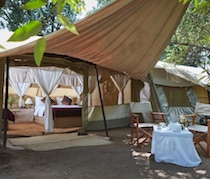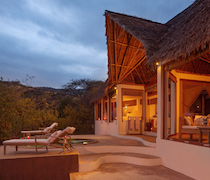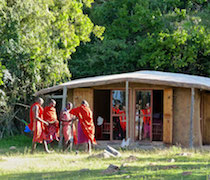Walking with the Maasai
Quite possibly one of the loveliest three days I've had was walking with the Maasai. We chatted about their culture, looked out over stunning vistas, ate amazing food and slept in a different place every night! Truly dreamy!
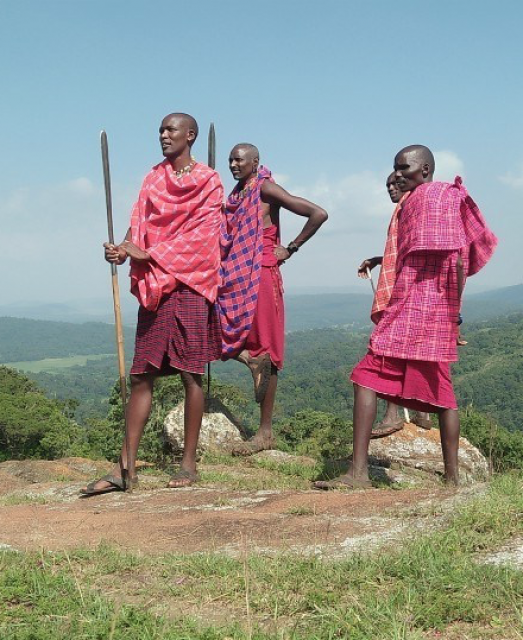
Vietnamese spring rolls with peanut dip, fresh Greek salad, homemade hummus and pitta bread! Looking at this elaborate spread, laid out on a foldout table surrounded by safari chairs on a hill overlooking an emerald valley, I knew immediately this was to be far superior to the usual camping experience. This trip – I realised on my first taste of the delicate translucent spring roll – was going to be good.
The Loita Hills, a range of mountains rising up between the Maasai Mara and Magadi, has rarely been written about in tourist publications. But this is an omission. These striking hills are one of the last remaining parts of Kenya that hasn’t been partitioned, where you can wander freely for days, clambering up cliffs and plunging into waterfalls on a whim, and camping in secluded spots wherever you choose.
It was in these lovely hills that Jan Grootenhuis established Jan’s Camp, back in the 1980s. When Adrian Hughes took over Jan’s Camp, he quickly realised the potential of the area. Exploring the hills on foot, he was bowled over by its beauty and freedom. The result of this is Maasai Trails.
When I embarked on the walk, I knew little about the area. The Mara I knew, and Magadi too, but these rolling hills between the two were little more than a backdrop to me. This was to change.
Safarilink flew us to the Mara, giving us views of a land that was unusually green after the recent rains. Adrian met us at Siana airstrip and drove us through the southern part of the Mara into the foothills of the Loita Hills. We stopped on a viewpoint where we met the Maasai who were to be our guides for the trip: Lemeria Konatti, Panae Meipuki and Ntiyani Kamomon. Overwhelmed by the views tumbling from our peak in every direction, I barely noticed the guys setting up lunch with the speed and efficiency of a team of silver service waiters.
While we ate, our guides weighed all the luggage and camping gear so as to distribute it equally amongst the donkeys, showing genuine care for the animals as they balanced each donkey’s load.
We set off, striding through open plains surrounded by dense forest, across a valley and through some marshes. Clear blue skies made the green somehow greener, and the sunlight glinted off the patches of water left by the night’s rains. Our guides – ahead of us and behind us – were happy to answer any questions we had on all subjects, ranging from the flora we were walking through, to their traditions, to what they thought about cows. Cows, of course, feature large in the life of a Maasai, and our new friends were keen to describe in depth the ways they are distributed, inherited, and owned.
Adrian’s signature move is to stand, legs astride, arms flung wide, overlooking a broad vista, and proclaim at volume: AFRICA! And walking through the Loitas it’s easy to be stirred by his enthusiasm. This land, unfenced as far as the eye can see, epitomises the vast space of this continent in the way few places now do. Africa spills from the escarpments, unfurls across the plains and fades to mist on the distant horizons.
After wading across the glistening Ol Lasur River, we rounded a corner and entered our camp. Some of the team – again with professionalism and expertise – had beaten us to it, and had set up camp. As with the food, attention to detail was extraordinary: a shower tent, discretely set in a copse, with a branch towel rail, mirrored beauty set hooked to a branch, and shampoo and body wash in a little pocket; beautiful pop tents set at a discrete distance from each other equipped with bedding and towels; and a soaring fly sheet shading a spacious mess area. The bar was set up, tea and coffee available, and hot water ready for those who wanted showers.
While the sun turned pink over our heads and we celebrated this daily event with sundowners, three Morans passed by. After their circumcision and before becoming the guards of their people, young Maasai are free to wander the area. Theatrically made up, legs painted ochre and foreheads adorned with headdresses, they tossed their plaits and welcomed us to their camp with magnificent distain.
A man of indeterminate age, known to our guides simply as Dorobo after his tribe, strolled into camp, knelt at our fire, and demonstrated the making of poison arrows. Squatting by the flames, he carved the arrow, chewing roots and rolling their glue in his hands, slitting feathers and attaching them with goat tendons, and forming the arrowhead with chicken wire and chain link. To my disappointment, he refused to share the recipe for the poison he dabbed on its lethal tip.
The following morning, after a grandiose breakfast of fresh fruits, sizzling sausages, bacon and eggs, and freshly brewed coffee, made even more dramatic by the mist lying mysteriously beneath the peaks, we walked to the highest point of the hills – Oltyiani – learning as we did so the story of how the Forest of the Lost Child, through which we walked, got its name. Once upon a time, two small girls competed to collect ripe berries without opening their eyes. The older child sneaked a peak and won. The younger, dejected when she opened her eyes on her pitiful collection of unripe berries, returned alone to the animal-filled forest to gather more. And was never seen again. ‘She must have turned into a tree,’ said our guide. ‘Or a rock.’
As we climbed paths weaving through dense undergrowth, we saw fresh elephant dung and our Maasai guides told us what we should do if we came face to face with a big tusker. With slight trepidation, I imagined flinging myself out of the way of a tusk, or plunging to the ground and lying flat as we were told to do should we encounter a buffalo. Several viewpoints along the ascent gave us a taste of the stunning views that spooled from the peak on all sides when finally we stepped from the forested slopes and emerged into the clearing at the top.
After descending through a less dense section of the forest, we spent the day strolling across lush plains and gently rolling hills, stopping for lunch at a leafy shaded spot, and ending at a second idyllic suddenly-sprung campsite, this time in a leafy glade. Another decadent dinner preceded a night of deep and exhausted sleep in tents furnished with mattresses and solar lamps. After breakfast – fresh fruits after a three-day hike: impressive! – we skidded down a plunging path from the hills to the blistering flats of Magadi where we were met by the team from Lentorre. Arriving after a short drive at this luxurious lodge was the icing on the cake. We wallowed in our private plunge pools soothing aching limbs, enjoyed a game drive with sightings of herds of zebra and buffalo, sipped our sundowners on a hillock overlooking the plains, and were treated to a surprise visit from a nocturnal aardwolf on our way back into camp. There we hung out in the hide overlooking the waterhole, then wined and dined and slept the sleep only those who have trekked over the Loitas can.
Tamara Britten, 01 September 2019
Published also in: Nomad Magazine
About the region
Maasai Mara
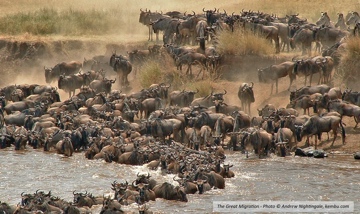
Famous around the world for its exceptional, abundant wildlife, the Maasai Mara National Reserve has become known as the Seventh Wonder of the World. Not only are all the members of safari’s Big Five found here, but over 100 other mammal species and over 450 bird species live within the reserve.
Read more about Maasai MaraWhere to stay
Speke’s Camp is a traditional safari camp on the eastern edge of the Maasai Mara National Reserve. The camp is surrounded by indigenous trees near the banks of the Olare Orok River. The 10 en-suite tents are decorated in traditional safari style with wooden chests, ...
Lentorre Lodge, in the Lake Magadi area, is an elegant lodge on an escarpment with stunning views on all sides. The luxury lodge opened in 2014. The 6 en-suite cottages - 4 double and 2 family - are adorned with stylish hand-carved furniture. Each cottage has a private plunge ...
Jan’s Camp is a small and authentic safari camp on a ridge looking across the Loita Hills, and the forest evocatively known as the Forest of the Lost Child. The 3 en-suite huts are built according to Maasai tradition with additional modern touches. There are ...
